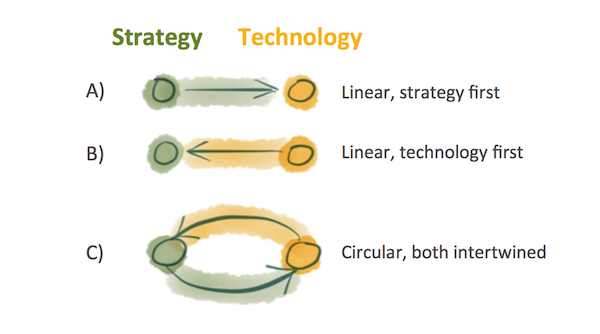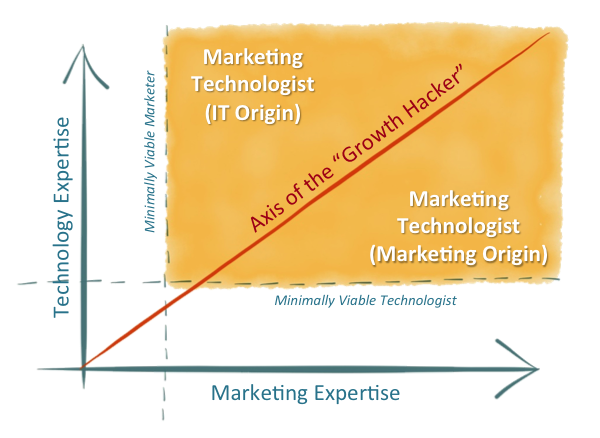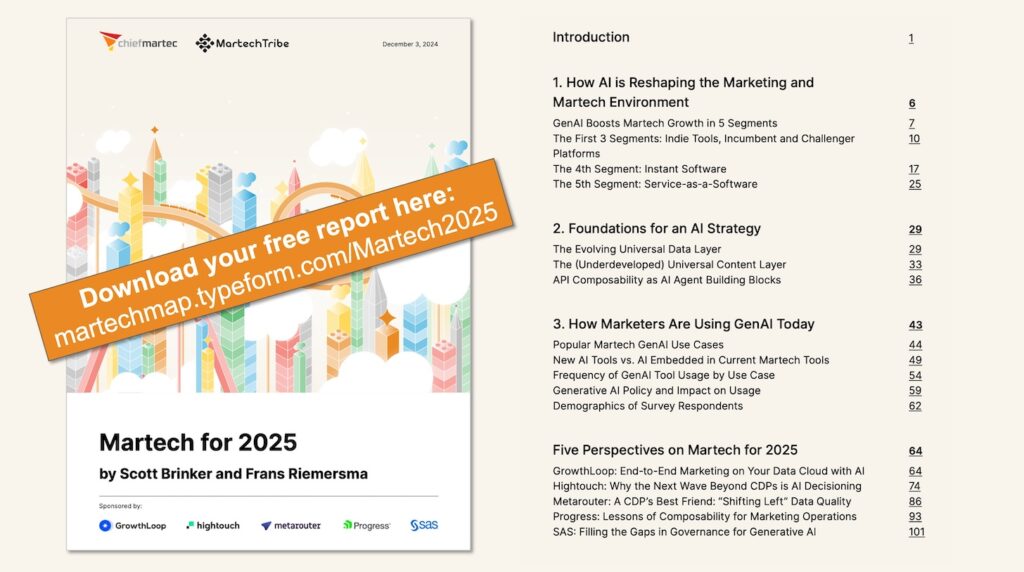Joe Pulizzi and Robert Rose covered my latest marketing technology landscape as part of their PNR: This Old Marketing podcast this week. They start on this segment around the 24:49 mark, with a riff on the Saturday Night Live The Rent Is Too Damn High skit. “Digital marketing is too damn complicated!”
It’s a terrific discussion about the interplay between marketing, technology, IT, strategy, and process. These were some of the points raised in their chat:
- “Technology is definitely outpacing our ability to consume it as marketers.”
- Buying technology is not a good way to figure out your strategy.
- Most marketers aren’t using the technology they already have very well.
- These problems happen when marketers are in charge of technology purchases.
- Marketing and IT need to be better aligned and more collaborative.
- You should determine your strategy and process first, and then find the right software to execute that — fit the tool to the problem, not the problem to the tool.
- The only thing technology can do is make your processes more efficient.
I agree enthusiastically with about 75% of that. But there are three points I’d make:
- Marketing technology is not just about efficiency — it’s about experiences.
- The relationship between strategy and technology is circular, not linear.
- Marketers cannot abdicate their responsibility to understand technology.
Strategy, marketing, and technology are all intertwined. To reference the How to Draw an Owl post from Seth Godin that Joe and Robert mention later in their podcast, the reality is more complex than just drawing two circles.
Marketing technology is about both efficiency and experiences
Here’s the one quote from the podcast that I really disagree with (emphasis partly mine):
“Figure out your process first. And then get aligned with your internal IT guys to figure out what it is you exactly need to facilitate. Because that’s the only thing that technology will ever, ever do. The only thing technology will ever do is facilitate a process that you have more efficiently. That’s all it’s ever going to do.”
Um, no. That trivializes the role of technology in modern marketing too much.
Marketing technology is not just about making existing processes more efficient. It’s the interface by which marketing sees and touches the digital world. Your choice of marketing software — and how you use it — will shape the experiences you deliver to prospects and customers.
Examples include: web and mobile marketing apps, webinar and virtual event software, personalization, gamification, interactive ads, and so on. In content marketing, Uberflip is a great example of marketing software that is more about experience than efficiency.
Other marketing technology is focused on efficiency, but not always by facilitating existing processes. In many cases, it’s about creating entirely new kinds of processes that weren’t even possible before.
For instance, using marketing automation to simply schedule batch-and-blast email is an example of making an existing process slightly more efficient. But the bigger opportunity is to create more personalized, behavior-driven nurturing processes that weren’t conceivable with manually operated email marketing. By the way, this doesn’t just make lead nurturing more efficient — it can make it a much better nurturing experience for your audience too.
I do agree with Joe and Robert that technology is not a magic bullet. It won’t absolve you of the need to produce brilliant content. But the interplay between technology and strategy is more complex than one merely being the handmaiden of the other.
The relationship between strategy and technology is circular
Joe and Robert make the excellent point that you shouldn’t buy a bunch of technology and then try to figure out what strategy you can create with it — Option B) in the sketch below. I wholeheartedly agree. No technology is a strategy-in-a-box.
However, simply inverting that approach into Option A) — define your strategy, and then go looking for technology to help implement it — isn’t quite right either.
Why? Because technological innovations change what kinds of strategies are possible. If you don’t let technology influence and inspire your strategy, you’re missing the opportunity to innovate your own business.
The right approach is Option C), more of a circular relationship. You want to understand what is technically possible — a frontier that is constantly advancing — to inform your strategy development. Your strategy then guides where you make greater technology investments. And what you learn from using that technology, especially as it evolves, should feedback into the refinement of your strategy. Managed well, this can be a virtuous cycle.
Keep in mind this Steve Jobs quote: “People don’t know what they want until you show it to them.” And Henry Ford, who said, “If I had asked people what they wanted, they would have said faster horses.” Innovation is often achieved through non-linear leaps.
Continuously experimenting with new, emerging technologies does not have to be the negative “shiny object syndrome.” If it’s done in moderation, as part of an intentional exploration of how your business can harness new innovations, it can be an evergreen source of competitive advantage.
Marketers must take responsibility for their technology
Joe and Robert attribute a quote to Scott Stratten of UnMarketing fame, “We suck at the technology we have, much less buying anything new.” (Although with a little bit of Googling, I haven’t been able to find that quote.)
I don’t disagree with the diagnosis. After all, this explosion of technology is a fairly new aspect of marketing, so it’s not surprising that we collectively have little professional intuition about how to harness and manage it. However, the answer is not to downplay technology. The answer is to get better at using it well.
The reason why the CMO will spend more on technology than the CIO is because it’s through software-mediated channels that we’re engaging our audience. Marketing is increasingly about designing and delivering customer experiences, and software is the digital clay we use to sculpt them. The CMO is responsible for that outcome, so it makes sense that the CMO should take a leadership role in the technology strategy to achieve it.
Of course, marketing and IT should work together. Marketing must adhere to IT governance as much as it does financial governance. Security, regulatory requirements, business continuity, integration with the rest of a company’s IT systems, etc., are all important facets of good technology management. Marketing cannot be a rogue state.
But if marketing doesn’t really understand technology — and IT doesn’t really understand marketing — then their “collaboration” can all too easily look like this: Marketing asks for faster horses. IT gives them faster horses. The automobile passes both of them by.
Other things being equal, IT will seek to minimize costs and risks in technology purchases. That’s a valuable perspective — but it’s not the only one that matters. Customer experience matters. Marketing performance matters. And the software that is the cheapest or easiest to buy may not be the most effective for marketing’s purpose. Standardizing on everything from GigantorSoft may optimize procurement — but that’s not as important as optimizing customer acquisition and delight.
Marketing must have a strong enough grasp of technology to advocate for the software to achieve its goals — and, more importantly, to be able to apply it effectively when they get it. But how do we get there from here, if marketing doesn’t have those capabilities today?
The best path I’ve seen is for marketing and IT to embrace a class of hybrid professionals called marketing technologists. These are people with expertise in both marketing and technology, and they fluidly intermingle the two disciplines.
They may come from a predominantly IT background or a marketing one, but they are credible on both dimensions. They may directly report into IT or marketing — I’ve seen both work, but the latter is more common — but they serve the mission of smartly applying technology in the pursuit of brilliantly effective marketing.
Whether you love or hate the term “growth hacker,” that’s an apt phrase for some of the best work that marketing technologists do.
Not everyone in marketing needs to be a marketing technologist. But having that capability within marketing’s team changes marketing’s relationship with technology. It’s no longer the way a Neanderthal might look at fire, “Oooh, pretty! Ouch! Ouch! Ouch!” It’s more like how a blacksmith harnesses fire to forge objects of great strength and beauty.






Scott….
This is such a wonderful post…. Your subtle (but very important) nuanced change in the intertwining of the two is right on the money in my book… and you’ll get no argument from me there…. I would agree – even if I didn’t elucidate it as well in the podcast…
I guess the only point I’ll take at all is where you disagree with my assessment of technology…
If i’m “trivializing” it… you may be romanticizing it a bit… 🙂 Any company can invest in – and too many over invest – the promise of “experience” creating technology. The challenge is that capability alone does not actually compel a consumer to become a lead, to purchase or to evangelize the brand… Only we (as humans) can actually create the experiences that, facilitated by great technology, can produce the value that consumers find attractive enough to engage with.
And that’s really my point about marketers stepping up and making sure that they first understand what they’re trying to do. A chainsaw in my hands is nothing but a useless and dangerous weapon – whereas in an artist’s hands it becomes a thing that creates beautiful ice sculpture and in a lumberjack’s hands becomes an efficient means to produce lumber… Technology, by its very definition, is but the application of tools to solve a problem.
Of course I agree with you and think that marketers should be aligned with technologists who can inspire the marketer with the capabilities that new innovations bring…. But too often that “shiny object syndrome” can blind the marketer into thinking that the giant shiny new platform (or capability) is important – when it’s actually not. So – IMHO – strategy first (inspired by the capabilities that innovative technology *might bring*) and then application of the technology to solve the challenge.
Keep burning my friend… This was a really good one!!
Cheers,
~rr
Thanks, Robert — first for covering this topic in your podcast with Joe (including the very kind compliment at the start of that segment) and for taking the time to chime in on this post. And, while I’m at it, for all the great support you’ve given me and my blog for quite some time. I really appreciate it.
I had a feeling that we actually did agree on many of these points — I almost wrote that at the end of the post, but I didn’t want to presume. However, since some of the remarks in your podcast did reflect concerns that I know others have had with the often awkward collision of marketing and technology, it seemed like a good context for engaging in a little debate.
And to emphasize: I completely agree with you that it’s humans who must drive the creation of great customer experiences with technology as their brushes, paint, and canvas.
Indeed, I have romanticized the marketing technology ideal above. Technology strategy and management is hard and often messy. And I think we both agree that it’s better for marketers to take small steps that they can handle well rather than letting dreams of technology nirvana get too far ahead of their abilities. The important thing, I believe, is to keep making forward progress: marketing is unlikely to be less entwined with technology in the years ahead.
Funny enough, I actually find the situation somewhat analogous to content marketing and the mission of the CMI. Great content marketing is incredibly important. But it’s also actually hard to do well — and I’m sure you’ve seen many cases where people’s ambitions for trying to do too much, too quickly results in a content quagmire. But even though it’s challenging, marketers can’t afford to ignore it or take too much of a “hands off” approach by outsourcing it wholesale to someone else. It’s a big part of what modern marketing is all about.
And so a little romance is probably good to inspire people to embrace these new opportunities. But like any romance, there’s more to it than wine and roses. 🙂
Thank you again!
Scott,
As an enterprise architect, I first commend you for your insights into technology and marketing aspects . I have been working through a number of reference architectures to support digital marketing and in most of these endeavours ran into the same “traditional IT architecture will not work here” wall each time.
This “awkward collision of marketing and technology” as you stated is a serious challenge for architects, because we are dealing with a new revolution, rich and diversified applications landscape and still very immature consolidated suite of products. This ICT and marketing “language and cultural divide” makes it extremely difficult to put the marketing genie in the proverbial architectural box. I have learned that I need need a lamp instead of the box so to speak.
Your articles and references into the marketing revolution/collision as it unfolds has been invaluable for me to build a more acceptable reference architecture that will support this digital marketing and technology collision of two galaxies.
Thank you for this very beautifully articulated debate and information you bring to the table.
Cheers,
Henk
Hi, Henk — thanks for the comment. I really appreciate you sharing your thoughts from an enterprise architecture perspective.
While this “collision” is unlike anything that marketing has had to deal with before, it is good to note that it’s certainly not a standard playbook from the IT side either. There’s a tremendous amount of knowledge and experience in technology management that IT professionals bring to bear on this challenge — for instance, what “enterprise architecture” is and why it’s so important. But from that foundation, something new must be synthesized.
If ever you’d be comfortable sharing some of the “best practices” that you’re discovering in your work on this mission — what an acceptable reference architecture looks like from your view — I’d love to do a Q&A with you for the blog about them. I’m sure many other readers would benefit from what you’ve learned.
Godspeed!
I’d be very interested in that Enterprise Architecture best practices discussion as well. We marketers have a vast array of tools available to us today, as highlighted in Scott’s latest chart. How all these applications integrate and interoperate together in the backoffice, or cloud is a major stumbling block for many organizations. Startups are often able to avoid some of the challenges that more mature businesses with legacy on-premise IT infrastructures are faced with. So yes, please let’s have that discussion.
Scott, thank you.
As a guy that has a history as a system administrator, programmer, philosopher, lawyer, marketing agency principal and chief marketing officer, this post echoes ideas that I’ve had since the early 2000s. Both technology and marketing are (in their most basic forms) communication vehicles…one being the vehicle the other, the map.
As you’ve described it, the convergence of these three crosses the spectrum of the brain. From the logical linear processing of the left side and the creative, processing side of the right, the ability to multi-process does not lead to a dead end. Rather determining destination, execution and tactics allows for continual refinement.
Years before Marissa Mayer stepped into the spotlight at Yahoo, I was fascinated by her undergraduate field of study at Stanford linguistics, philosophy, cognitive psychology, and computer science classes. Merging these disparate fields meant understanding the tools and effects of technology.
This is a very valuable skill, yet organizations do not have an understanding for the rare find of the humanities technologist. It will become increasingly important.
Scott, Great post.
Fantastic insights and I love the concept of a Marketing Technologist.
I have been looking for a concise way of explaining my team’s role within the larger organisation. This title and mission fits perfectly.
Keep up the great work on the blog and graphics.
– Adam
Scott, great quotes from your post –
“Keep in mind this Steve Jobs quote: “People don’t know what they want until you show it to them.” And Henry Ford, who said, “If I had asked people what they wanted, they would have said faster horses.” Innovation is often achieved through non-linear leaps.”
To me, an old school marketer, these both speak to physical product, #1 of the OG 4 P’s of marketing 🙂 I think B2B companies especially, can feel like their tangible product – sold by touch and feel and personal selling – can’t benefit from newer on-line ways to promote and communicate to customers. It’s too abstract, beyond e-commerce, which everybody gets.
I’m a freelance writer, long fascinated by Martech from its infancy. I tried for years to get my employer, who needed one desperately, to get a CRM. Painful, I gave up.
Great post!
Joan Kent